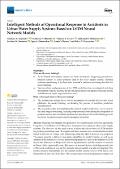Показать сокращенную информацию
Intelligent Methods of Operational Response to Accidents in Urban Water Supply Systems Based on LSTM Neural Network Models
| dc.contributor.author | Kapanski, A. A. | |
| dc.contributor.author | Hruntovich, N. V. | |
| dc.contributor.author | Klyuev, R. V. | |
| dc.contributor.author | Boltrushevich, A. E. | |
| dc.contributor.author | Sorokova, S. N. | |
| dc.contributor.author | Efremenkov, E. A. | |
| dc.contributor.author | Demin, A. Y. | |
| dc.contributor.author | Martyushev, N. V. | |
| dc.coverage.spatial | Basel | ru_RU |
| dc.date.accessioned | 2025-06-26T13:36:33Z | |
| dc.date.available | 2025-06-26T13:36:33Z | |
| dc.date.issued | 2025 | |
| dc.identifier.citation | Intelligent Methods of Operational Response to Accidents in Urban Water Supply Systems Based on LSTM Neural Network Models / A. A. Kapanski, N. V. Hruntovich, R. V. Klyuev [et al.] // Smart Cities. – 2025. – Vol. 8, Iss 2. – P. 1–21. | ru_RU |
| dc.identifier.uri | https://elib.gstu.by/handle/220612/41987 | |
| dc.description.abstract | This paper investigates the application of recurrent neural networks, specifically Long Short-Term Memory (LSTM) models, for pressure forecasting in urban water supply systems. The objective of this study was to evaluate the effectiveness of LSTM models for pressure prediction tasks. To acquire real-time pressure data, an information system based on Internet of Things (IoT) technology using the MQTT protocol was proposed. The paper presents a data pre-processing algorithm for model training, as well as an analysis of the influence of various architectural parameters, such as the number of LSTM layers, the utilization of Dropout layers for regularization, and the number of neurons in Dense (fully connected) layers. The impact of seasonal factors, including month, day of the week, and time of day, on the pressure forecast quality was also investigated. The results obtained demonstrate that the optimal model consists of two LSTM layers, one Dropout layer, and one Dense layer. The incorporation of seasonal parameters improved prediction accuracy. The model training time increased significantly with the number of layers and neurons, but this did not always result in improved forecast accuracy. The results showed that the optimally tuned LSTM model can achieve high accuracy and outperform traditional methods such as the Holt–Winters model. This study confirms the effectiveness of using LSTM for forecasting in the water supply field and highlights the importance of pre-optimizing the model parameters to achieve the best forecasting results. | ru_RU |
| dc.language.iso | en | ru_RU |
| dc.publisher | MDPI | ru_RU |
| dc.subject | Recurrent neural networks | ru_RU |
| dc.subject | Long short-term memory model | ru_RU |
| dc.subject | Hydraulic pressure | ru_RU |
| dc.subject | Water supply systems | ru_RU |
| dc.subject | Digital infrastructure | ru_RU |
| dc.subject | Internet of Things | ru_RU |
| dc.subject | Pressure forecasting | ru_RU |
| dc.subject | Water supply reliability | ru_RU |
| dc.title | Intelligent Methods of Operational Response to Accidents in Urban Water Supply Systems Based on LSTM Neural Network Models | ru_RU |
| dc.type | Article | ru_RU |
| local.identifier.doi | 10.3390/smartcities8020059 |
